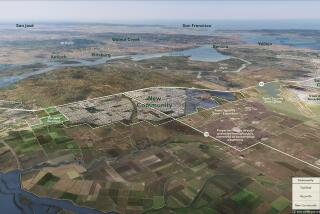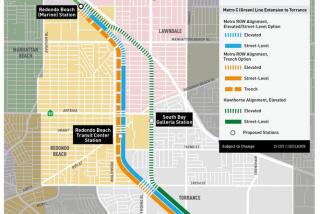Simi as Seen From a Monorail
- Share via
SIMI VALLEY — Welcome to Simi Valley. Please keep your hands and feet inside the monorail at all times.
By 2020, if Tim Hodge has his way, one of the safest cities in the United States could resemble the happiest place on Earth in how it moves its residents about.
Hodge heads the Vision 2020 Executive Committee, and on Saturday he and about 50 others gathered in the City Council chambers to discuss projects and policies the council could adopt to help make decisions for the city’s future.
Since last fall, residents have been meeting in six committees to work on the Vision 2020 statement, a 1 1/2-inch-thick draft document now in the refinement stage.
The group has made recommendations on aesthetics, zoning changes and cultural opportunities, as well as on how to attract new businesses that can provide jobs that pay about $50,000.
*
Among the dreams and hopes put forth during Saturday’s Focus Forum was a proposal by Hodge to make Simi Valley one of the few cities to have a monorail.
The benefits of a Disneyland-style, intracity monorail, Hodge said, include attracting visitors who can’t wait to say they have ridden it, as well as giving residents a way around town while taking cars off the road.
“Who wouldn’t want to be there? Who wouldn’t want to ride it?” Hodge said.
What those riders would see on their citywide journey is being overseen by the Development/Construction Committee. Panel member PaulaMarie Young said her committee has recommended everything from eliminating concrete bumpers in parking lots to forcing developers to build benches along sidewalks that would make the area more pedestrian-friendly.
“A beautiful city is really a collection of a lot of little details,” Young said, while using overhead images to point out things that make a city aesthetically appealing.
The committee recommends that new developments incorporate “decorative entry statements” at their main entries. Also, buildings that can be seen from the train tracks or the Arroyo Simi should include attractive architectural details.
*
In a nod to the past, Young recommended sidewalks be moved away from curbs behind some type of boulevard strip so pedestrians would not have to endure changes in elevation as they walk across residential driveways.
As for the sidewalk seating proposal, Young said such improvements should not exceed 50% of a project’s building permit cost.
The committee also has recommended allowing seven-story buildings along Alamos Canyon Road near the Simi Valley Landfill. Such commercial structures would neither detract from the surrounding foothill topography nor create a sense of urban sprawl in the city, a committee member said.
Providing enough industrial space to allow for a balanced living and working environment is the undertaking of the Business/Economic Issues Committee. Committee member Ed Levine said there are several million square feet of industrial space in the city’s west end and at the south end of Tapo Street.
*
The trick will be to come up with developer incentives, Levine said.
But not everyone was willing to go along with what seemed like a slew of city-funded programs and increased burdens on property owners.
“Think freedom,” said Emma Heyneman, an 18-year resident of Simi Valley. “Do you want a militaristic community or do you want a beautiful community?
“I think they can have what they want, but they have to be careful that they don’t go too far against the rights of property owners,” she said.
More to Read
Sign up for Essential California
The most important California stories and recommendations in your inbox every morning.
You may occasionally receive promotional content from the Los Angeles Times.










